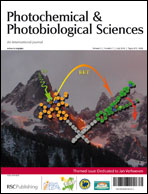Probing the interactions between disulfide-based ligands and gold nanoparticles using a functionalised fluorescent perylene-monoimide dye†‡
Abstract
The binding of disulfides to

- This article is part of the themed collection: In honour of Jan Verhoeven

 Please wait while we load your content...
Please wait while we load your content...